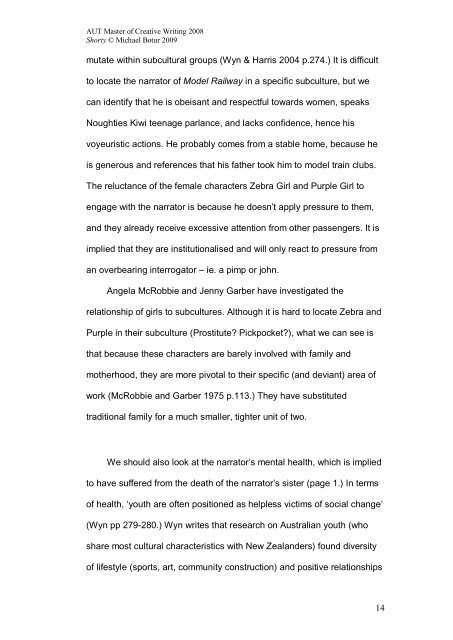AUT Master of Creative Writing Thesis Exegesis - Scholarly ...
AUT Master of Creative Writing Thesis Exegesis - Scholarly ...
AUT Master of Creative Writing Thesis Exegesis - Scholarly ...
You also want an ePaper? Increase the reach of your titles
YUMPU automatically turns print PDFs into web optimized ePapers that Google loves.
<strong>AUT</strong> <strong>Master</strong> <strong>of</strong> <strong>Creative</strong> <strong>Writing</strong> 2008<br />
Shorty © Michael Botur 2009<br />
mutate within subcultural groups (Wyn & Harris 2004 p.274.) It is difficult<br />
to locate the narrator <strong>of</strong> Model Railway in a specific subculture, but we<br />
can identify that he is obeisant and respectful towards women, speaks<br />
Noughties Kiwi teenage parlance, and lacks confidence, hence his<br />
voyeuristic actions. He probably comes from a stable home, because he<br />
is generous and references that his father took him to model train clubs.<br />
The reluctance <strong>of</strong> the female characters Zebra Girl and Purple Girl to<br />
engage with the narrator is because he doesn’t apply pressure to them,<br />
and they already receive excessive attention from other passengers. It is<br />
implied that they are institutionalised and will only react to pressure from<br />
an overbearing interrogator – ie. a pimp or john.<br />
Angela McRobbie and Jenny Garber have investigated the<br />
relationship <strong>of</strong> girls to subcultures. Although it is hard to locate Zebra and<br />
Purple in their subculture (Prostitute? Pickpocket?), what we can see is<br />
that because these characters are barely involved with family and<br />
motherhood, they are more pivotal to their specific (and deviant) area <strong>of</strong><br />
work (McRobbie and Garber 1975 p.113.) They have substituted<br />
traditional family for a much smaller, tighter unit <strong>of</strong> two.<br />
We should also look at the narrator’s mental health, which is implied<br />
to have suffered from the death <strong>of</strong> the narrator’s sister (page 1.) In terms<br />
<strong>of</strong> health, ‘youth are <strong>of</strong>ten positioned as helpless victims <strong>of</strong> social change’<br />
(Wyn pp 279-280.) Wyn writes that research on Australian youth (who<br />
share most cultural characteristics with New Zealanders) found diversity<br />
<strong>of</strong> lifestyle (sports, art, community construction) and positive relationships<br />
14
















